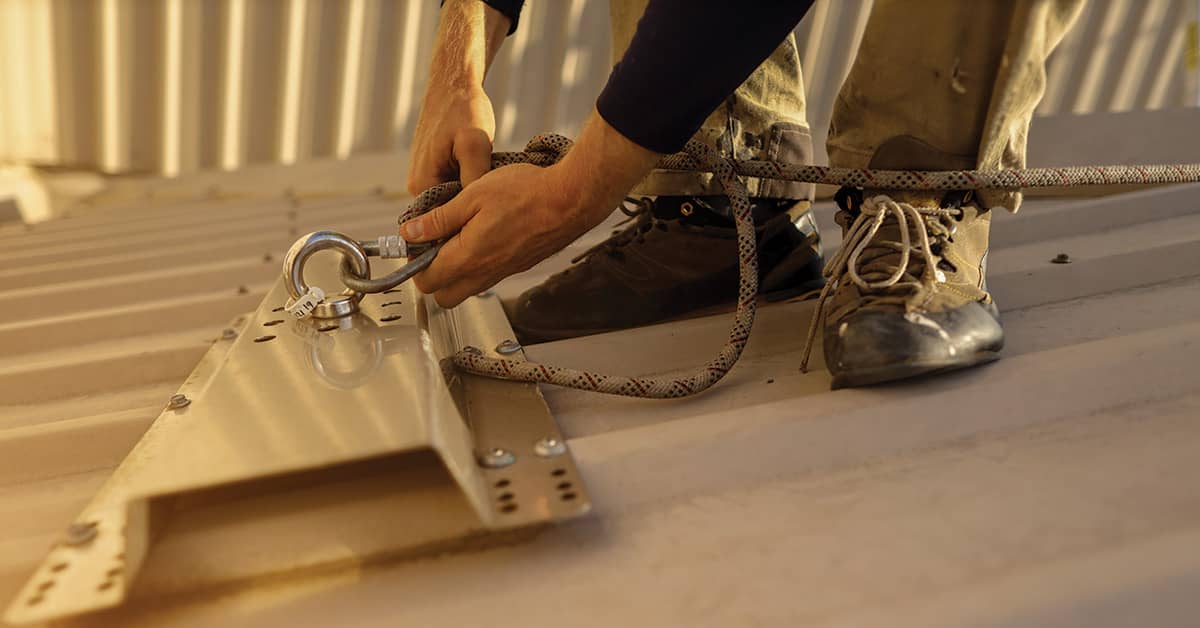Understanding anchor points for fall protection
Date Posted: 07/24/2023

Must an anchor point be able to support 5,000 pounds? Not necessarily. But how do you identify alternatives?
Anchor points must either be able to support 5,000 pounds for each worker, or must meet a safety factor of two. That safety factor depends on things like the weight of the employee, the potential falling distance, and the use of deceleration devices that reduce the arresting force.
If the anticipated force is 1,000 pounds, for example, then the safety factor requires an anchor capable of supporting 2,000 pounds. Working with a fall protection provider should help determine the arresting force.
The other challenge is getting an assessment by a qualified person. The regulation at 1910.140 allows an anchor “designed, installed, and used under the supervision of qualified person” as part of a complete personal fall protection system.
This raises questions of how to evaluate the strength of a potential anchor. Anchor points may be:
- Engineered or certified.
- Non-engineered or non-certified.
Engineered or not?
An engineered point is designed as an anchor, like a ring that bolts in place or a portable system with weights. Although employers probably don’t test them after installation, they should meet OSHA’s requirements when properly installed. Engineers design these systems to meet the strength requirements.
More often, employers use non-engineered or field-expedient anchors. Determining whether a proposed anchor point is strong enough requires an evaluation. For example, many employers use steel I-beams or H-beams as part of an anchor system. This can be acceptable using an appropriate clamp or attachment, but not when simply wrapping a strap around the beam (since sharp edges could cut the strap). Other building structural supports, however, many not be strong enough.
How strong is it?
Determining the strength of the potential anchor requires an evaluation because you probably won’t test it by dropping a weight. The regulation requires that the system be designed and installed by a qualified person. But what does that mean? Employers can use structural beams, even if they weren’t “installed” as anchors. However, the qualified person would evaluate the beam and other components (including the means of attachment) to determine whether the complete system is satisfactory.
For non-certified points, the qualified person might look at the anchor attachment, and even look at engineering drawings for the facility to see the grade of steel used. In addition, the person might evaluate any recommendations from the fall protection manufacturer regarding compatibility.
Note that employees should never use things like ladders, scaffolds, or guardrails as fall protection anchors. For working on flat roofs, some employers want to use existing structures like a flagpole or air conditioner as an anchor. Those options might be conveniently located, but they’re unlikely to qualify as acceptable as anchor points.
Employers lacking in-house expertise should work with a fall protection supplier who can suggest options and systems that should meet OSHA’s requirements. A good supplier may also have someone on staff who is qualified to oversee the system installation.
Finally, remember that if an employee falls, the anchor will undergo considerable stress, and the employer must inspect all system components to verify that they’re still safe to use. When using expedient structures, consider the potential effects on those structures if they arrest a falling worker. Building structures might be strong enough to arrest a falling worker, but that force could compromise structural integrity.
How Safety Management Suite Can Help
When you need answers on topics beyond the regulations, you probably check with other safety professionals in your network. If you’re still developing a network, try using the J. J. Keller® SAFETY MANAGEMENT SUITE Discussions area. You can post questions and request feedback from other safety professionals, learning from their experiences. You might even find some posted questions that you can help answer!
E-mail Newsletter
Sign up to receive the weekly EHS Insider email newsletter for safety articles, news headlines, regulatory alerts, industry events, webcasts, and more.